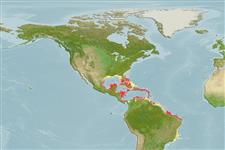Echinoidea |
Camarodonta |
Echinometridae
Environment: milieu / climate zone / depth range / distribution range
Ecology
Reef-associated; depth range 0 - 40 m (Ref. 83942). Tropical
Western Central Atlantic: USA to the West Indies.
Length at first maturity / Size / Weight / Age
Maturity: Lm ? range ? - ? cm
It was proposed that this species played an important role in the transformation of the coral community in reefs of Rhomboidal Cays, Belize. It used to be dominated by Acropora cervicornis, but was transformed to be dominated by Agaricia tenuifolia due to the herbivory of this species. It resulted to promoting the settlement and growth of Agaricia in the area (Ref. 86570). This is an intertidal species found in coral reefs and rocky bottoms (Ref. 83942). It inhabits reef areas (Ref. 415), particularly on beds of Agaricia sp. (Ref. 86574). This species shelters beneath rubble in turbulent reef habitats and takes exposed positions at the cays (Ref. 86570).
Life cycle and mating behavior
Maturity | Reproduction | Spawning | Eggs | Fecundity | Larvae
Members of the class Echinoidea are gonochoric. Fertilization is external. Brooding is common, eggs are held either on the peristome, around the periproct or deep into the concavities on the petaloids. Life cycle: Embryos develop into planktotrophic larvae (echinoplateus) and live for several months before they sink to the bottom using their tube feet to adhere on the ground where they metamorphose into young urchins.
Collin, R., M.C. Díaz, J. Norenburg, R.M. Rocha, J.A. Sánchez, M. Schulze, A. Schwartz and A. Valdés 2005 Photographic identification guide to some common marine invertebrates of Bocas Del Toro, Panama. Caribbean Journal of Science. 41(3):638-707. (Ref. 415)
IUCN Red List Status
(Ref. 130435: Version 2025-1)
CITES status (Ref. 108899)
Not Evaluated
Not Evaluated
Threat to humans
Human uses
| FishSource |
Tools
More information
Trophic EcologyFood items (preys)Diet compositionFood consumptionPredators Population dynamicsGrowthMax. ages / sizesLength-weight rel.Length-length rel.Length-frequenciesMass conversionAbundance Life cycleReproductionMaturityFecunditySpawningEggsEgg developmentLarvae PhysiologyOxygen consumption
Human RelatedStamps, coins, misc.
Internet sources
Estimates based on models
Preferred temperature
(Ref.
115969): 25.5 - 28.1, mean 27.3 (based on 172 cells).
Price category
Unknown.
